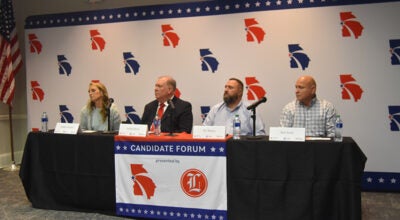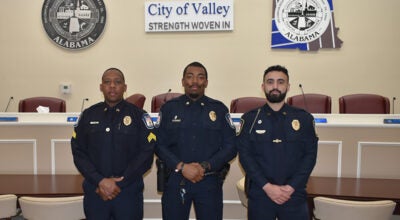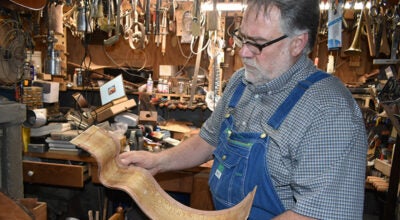Historical society speaker shares experience as extra in ‘Selma’
Published 6:00 am Wednesday, January 29, 2020
|
Getting your Trinity Audio player ready...
|
VALLEY — Events 55 years ago provided the backdrop of Sunday’s winter quarter meeting of the Chattahoochee Valley Historical Society.
Guest speaker Jim Patterson flew in from Washington, D.C. to discuss childhood memories he has of his father’s participation as an Alabama National Guardsman and his experience six years ago in the filming of the award-winning movie “Selma.” Patterson was cast as a movie extra portraying a news reporter of the period.
“Due to the magic of Hollywood, I was able to be in a movie at age 60 of an historical event that involved my father when he was 30,” he said.
Fifty-five years ago this March, a series of civil rights marches were organized in Selma, Alabama. The goal of the marches were to dramatize protest racial injustice in the deep South and to build momentum for the passage of a voting rights act. Despite the passage of the 1964 Civil Rights Act, elected officials in southern states were maintaining discriminatory practices that left the vast majority of African American residents unable to vote.
The first of the three marches took place on March 7, 1965. Local organizers James Bevel , Amelia Boynton and others led the march but were stopped near the Edmund Pettus Bridge by Alabama state troopers and county postmen, who beat them with billy clubs and tear- gassed them. Photographs of Boynton lying unconscious on the bridge shocked the world.
The second march took place two days later and was mostly a symbolic showing. It was led by Dr. Martin Luther King Jr., who led marchers to the bridge, and as state troopers parted to let them pass, the marchers turned and went back to the church where the march had been organized. At the time, they were under a federal injunction not to march until the matter could be settled in court.
The third march took place on March 21. When Alabama Gov. George Wallace announced that he would not protect the marchers, President Lyndon Johnson stepped in to do that. He federalized 1,900 Alabama National Guardsmen to do that along with FBI agents and federal marshals.
The march proceeded without opposition and arrived in Montgomery on March 24. An estimated 25,000 people entered the state’s capital city that day in support of voting rights.
The marches played a significant role in the civil rights movement. They played a big part in persuading President Johnson to seek legislation that became the 1965 Voting Rights Act. The bill was overwhelmingly approved by Congress and signed into law by the president on August Aug. 6, 1965, with Amelia Boyington Boynton present for the ceremony. The act prohibited the unfair practices that had prevented blacks from registering to vote.
Those events some 55 years ago now provided the backdrop of Sunday’s winter quarter meeting of the Chattahoochee Valley Historical Society. Guest speaker Jim Patterson flew in from Washington, D.C. to discuss childhood memories he has of his father’s participation as an Alabama National Guardsman and his experience six years ago in the filming of the award-winning movie Selma. Patterson was cast as a movie extra portraying a news reporter of the period.
“Due to the magic of Hollywood, I was able to be in a movie at age 60 of an historical event that involved my father when he was 30,” he said.
When he tells people he’s a non-fiction writer, they oftentimes confuse him with the other James Patterson. “They tell me my characters are so realistic,” he said, and I have to tell them that I’m not THAT James Patterson.”
Patterson said he was pleased that some motion pictures about the state had attained national archives recognition, among them The Phenix City Story and To Kill a Mockingbird.
He said the 1962 movie The Miracle Worker, which was filmed in north Alabama, is deserving of such recognition. Patty Duke, who was 16 years old at the time, won an Oscar in that film for her portrayal of a young Helen Keller.
National archives designation protects films for many years to come.
In the early 1960s, Patterson’s dad, James Glover Patterson (1933-2003), was with the National Guard unit based ab Fort Harold Calhoun in Fairfax. He saw service during such significant events as the Cuban Missile Crisis, the integration of the University of Alabama and the Selma-to-Montgomery march.
“I can remember him spending lots of time at the armory and can remember him taking me there when I was a small boy,” he said.
March 1965 was a dangerous period. “(Late night TV host) Johnny Carson joked that young men being sent to Vietnam were relieved that they would not be going to Selma,” Patterson said. “President Johnson described the KKK as domestic terrorists. My dad wore military fatigues and had an M-1 rifle when he went to Selma, Hundreds of guardsmen from all over the state were there. A major military presence no doubt prevented possible violence.”
For those who haven’t seen “Selma,” Patterson urges them to do so.
“Not because I’m in it, but because it’s a good movie,” he said.
The part of the movie he’s in was filmed near the Georgia Academy of Medicine in Atlanta in June 2014.
“The weather was really hot, and we had to wear heavy winter coats,” he said. “It was pretty cold in Selma in March 1965. We all got really hot. Making it worse was that we had to wear makeup.”
Another problem was that there were some hecklers present who didn’t care for the glorification of civil rights. “Someone kept driving a car past playing ‘Dixie’ real loud and there were some hecklers saying some really nasty things. They had to be moved away.”
Patterson said he was really disappointed they didn’t have any uniformed guardsmen as extras. That’s one of the roles he wanted because that’s what his dad did.
“They used actual footage from 1965,” he said. “They cast me as a reporter instead. They dressed me in clothing of the period. I got to meet other extras who had been reared in places like Selma, Birmingham and Gadsden. We had some really interesting conversations about what they remembered after the hecklers had been carried away. Members of the production company asked us about growing up in Alabama. It was a frightening time, and no one knew how it would turn out.”
Patterson said he could remember his dad talking about how hard it had rained on the day the marchers made it to Montgomery. That night there was a “Stars for Freedom” rally on a makeshift stage. There was so much thick mud on the ground that many of the celebrities had to be carried to the stage. They included Harry Belafonte, Tony Bennett, Frankie Laine, Peter, Paul and Mary, Sammy Davis Jr., and Joan Baez.
In the scene he’s in, George Wallace is addressing a crowd on the capitol steps. He was portrayed by a British actor named Tim Roth, who had some obvious trouble with the Southern accent, but besides that did a decent portrayal.
“Tom Wilkinson, the guy who played President Johnson, was also British,” Patterson said. “He was really good. He sounded Southern.”
A problem for Roth was that, as Wallace, he had to speak language he found personally offensive. The production crew had an interesting way to help him along. During breaks, some attractive black women that were part of the crew would hug and kiss him, letting him know it was okay; he was just acting.
Patterson said that his father had been issued live ammunition and officers had told the guardsmen that if they had any reservations about using it they couldn’t go.
“It was very tense,” Patterson said. “My dad had served in Korea and that the Selma march was more dangerous than anything he’d seen there . It was a milestone moment, an important moment for our state. The civil rights struggle was important historically, economically and culturally.”
Patterson said his dad felt he had taken part in something that was good. The guard presence discouraged attacks from anyone with violent intentions.
“My dad thought the world was big enough for everyone,” he said.
Patterson is a 1973 graduate of Valley High. He said that he’d had some great teachers and classmates during his time there. He also credits a great aunt who lived in Boston for having had a big influence on him. “She lived in a very diverse neighborhood in Quincy, Massachusetts,” he said. “I can remember her taking me to see the UN. I learned in the 1960s that the world was becoming more of an international community.”
That would no doubt help him later on in a career with the U.S. State Department that would include diplomatic service at U.S. embassies in Canada, the United Kingdom, France, the Netherlands, Mexico, Brazil and Chile.




